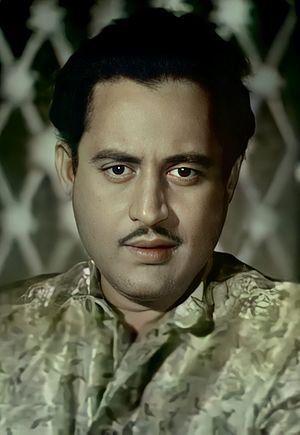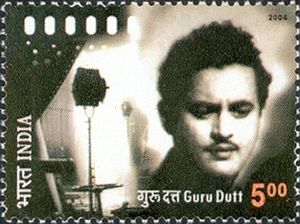Guru Dutt facts for kids
Quick facts for kids
Guru Dutt
|
|
|---|---|

Guru Dutt in Chaudhvin Ka Chand
|
|
| Born |
Vasanth Kumar Shivashankar Padukone
9 July 1925 Padukone, South Canara, Madras Presidency, British India (present-day Udupi District, Karnataka, India)
|
| Died | 10 October 1964 (aged 39) |
| Occupation |
|
| Years active | 1946–1964 |
| Spouse(s) | |
| Children | 3 |
| Relatives |
|
Vasanth Kumar Shivashankar Padukone (born July 9, 1925 – died October 10, 1964), known as Guru Dutt, was a famous Indian filmmaker. He was a director, producer, actor, choreographer, and writer. Many people consider him one of the best filmmakers in Indian cinema history.
Dutt was praised for his artistic style. He was known for using close-up shots and special lighting. He directed 8 Hindi films. Several of these films became very popular around the world.
His famous movies include Pyaasa (1957) and Kaagaz Ke Phool (1959). Also, Chaudhvin Ka Chand (1960) and Sahib Bibi Aur Ghulam (1962) are often listed as great Hindi films. Pyaasa was even on Time magazine's list of the 100 Greatest Movies. In 2012, CNN named him one of the "Top 25 Asian Actors."
Contents
Early Life and Family
Vasanth Kumar Shivashankar Padukone was born on July 9, 1925. This was in Padukone, which is now in the state of Karnataka, India. His family was Chitrapur Saraswat Brahmin. After a childhood accident, his name was changed to Gurudatta Padukone. People believed this new name would bring good luck.
His father, Shivashanker Rao Padukone, was a headmaster and a banker. His mother, Vasanthi, was a teacher and a writer. His parents first lived in Karwar before moving. Guru Dutt spent his early childhood in Bhowanipore, Kolkata. He learned to speak Bengali fluently.
He had one younger sister, Lalita Lajmi, who became a painter. He also had three younger brothers: Atma Ram (a director), Devi (a producer), and Vijay. His niece, Kalpana Lajmi, was also a well-known Indian film director, producer, and screenwriter. His second cousin, Shyam Benegal, is also a director and screenwriter.
Career in Films
Starting His Career
In 1942, Guru Dutt began studying at Uday Shankar’s School of Dancing and Choreography in Almora. He left in 1944. After that, he worked briefly as a telephone operator at a factory in Calcutta (now Kolkata). He soon left this job too.
Dutt then returned home to his parents in Bombay. His uncle helped him get a job with the Prabhat Film Company in Pune. This was a 3-year contract. At Prabhat, Dutt met two actors who became his close friends: Rehman and Dev Anand. Dev Anand later helped Dutt direct his first film.
In 1945, Dutt acted for the first time in Lakhrani. He played a small role. In 1946, he worked as an assistant director. He also choreographed dances for the film Hum Ek Hain. Dev Anand made his acting debut in this film.
His contract with Prabhat ended in 1947. Dutt's mother helped him get a job as a freelance assistant. But he lost this job too. He was unemployed for about 10 months. During this time, he enjoyed writing short stories for a magazine called The Illustrated Weekly of India.
His Big Break
After 1947, Dutt moved to Bombay. He worked with two top directors: Amiya Chakravarty and Gyan Mukherjee. Around this time, Dev Anand offered Dutt a job as a director. Anand had started his new company, Navketan.
When they were new to the film industry, Anand and Dutt had made a promise. If Dutt became a filmmaker, he would cast Anand as his hero. If Anand produced a film, he would ask Dutt to direct it. They kept this promise.
Anand hired Dutt to direct Baazi (1951). This was Dutt's first film as a director. The movie was a tribute to the 1940s film noir style from Hollywood. Baazi was a big success. After that, they made Jaal (1952), which Dutt also directed and Anand starred in. This film was also very successful.
Dutt later cast Anand in C.I.D. (1956). However, Dutt and Chetan Anand (Dev Anand's elder brother) had different ideas about films. This made it hard for them to work together again.
For his next film, Dutt directed and starred in Baaz (1953). This film did not do very well. But it brought together a group of talented people who would work with Dutt on many successful films. This group became known as the Guru Dutt team. It included people like actor-comedian Johnny Walker, cinematographer V.K. Murthy, writer-director Abrar Alvi, and actress Waheeda Rehman.

Dutt's next films were huge hits. These included Aar Paar (1954), Mr. & Mrs. '55 (1955), C.I.D. (1956), Sailaab (1956), and Pyaasa (1957). Dutt played the main role in three of these five films.
In 1959, Dutt released Kaagaz Ke Phool. This was the first Indian film made using CinemaScope. The film was about a famous director (played by Dutt) who falls in love with an actress (played by Waheeda Rehman). Even with this new technology, Kaagaz Ke Phool was a big disappointment at the box office. After this, Dutt felt his name might bring bad luck to films. So, other directors officially headed all future films from his studio. Kaagaz Ke Phool was the only film produced by Dutt that was a box office failure.
Later Films
In 1960, Dutt's team released Chaudhvin Ka Chand. M. Sadiq directed it, and Dutt starred alongside Waheeda Rehman. This film was a huge success. It helped Dutt recover the money he lost from Kaagaz Ke Phool. The film's title song, "Chaudhvin Ka Chand Ho," is in color. This is the only time you can see Guru Dutt in color in a film.
In 1962, his team released Sahib Bibi Aur Ghulam. This film was praised by critics. Dutt's student, Abrar Alvi, directed it. Alvi won the Filmfare Best Director Award for the film. Dutt starred in it with Meena Kumari, and Rehman and Waheeda Rehman had supporting roles.
In 1964, Dutt acted in his last film, Sanjh Aur Savera. He starred opposite Meena Kumari. Hrishikesh Mukherjee directed this film. Guru Dutt passed away in October 1964, leaving several films unfinished. He was supposed to be the lead in K Asif's film Love and God. But Sanjeev Kumar replaced him when the film was finished years later. He was also working on Picnic with Sadhana, which was never completed. He was set to produce and star in Baharen Phir Bhi Aayengi. Dharmendra took his place as the lead. This film was released in 1966 and was the last production from his team.
Personal Life
In 1953, Guru Dutt married Geeta Roy Chowdhuri. She later became known as Geeta Dutt. She was a very famous singer. They met while making the film Baazi (1951). They were engaged for three years. They faced a lot of family opposition but still married. In 1956, they moved to a house in Pali Hill, Mumbai. They had three children: Tarun, Arun, and Nina. After Guru and Geeta passed away, their children were raised by Guru's brother Atma Ram and Geeta's brother Mukul Roy.
Guru Dutt and Geeta separated before his death. He was living alone at that time. Geeta Dutt passed away in 1972 when she was 41 years old.
Death
On October 10, 1964, Guru Dutt was found dead in his apartment in Bombay.
At the time of his death, Dutt was working on two other film projects. One was Picnic, starring actress Sadhana. The other was director K. Asif's big film, Love and God. Picnic was never finished. Love and God was released two decades later. It was completely re-shot, with Sanjeev Kumar playing Dutt's role.
Legacy
His Success
Many people think Guru Dutt's films were not commercially successful. But actually, most of his films made money. Over time, his artistic goals sometimes changed how much money his films made. Movies like C.I.D., Baazi, Pyaasa, Kaagaz Ke Phool, Chaudhvin Ka Chand, and Sahib Bibi Aur Ghulam were new and different for Hindi cinema.
The only film produced by Dutt that lost money was Kaagaz Ke Phool. However, this film is now considered a cult classic. The DVD of Kaagaz Ke Phool includes a three-part documentary about Dutt's life and work. It is called In Search of Guru Dutt.
Guru Dutt, along with Raj Kapoor, Mehboob Khan, and Bimal Roy, was one of the few Indian directors. He was able to mix artistic quality with commercial success. This happened between the mid-1950s and mid-1960s. His brother Atma Ram dedicated his 1969 film Chanda Aur Bijli to him.
Honours and Recognition
Dutt is known for his creative use of light and shadow in his films. He created powerful images. He was also skilled at weaving many different themes into his stories.
Both Kaagaz Ke Phool and Pyaasa are considered among the greatest films of all time. They were included in Sight & Sound magazine's 2002 "Top Films Survey." This survey asked over 250 film critics and directors from around the world. In 2005, Pyaasa was added to Time magazine's All-Time 100 Movies list. In 2010, CNN named Dutt one of the "Top 25 Asian Actors of all time."
India Post released a postage stamp featuring Dutt on October 11, 2004. On October 10, 2011, a Doordarshan documentary about Dutt was shown. In 2021, author Yasser Usman wrote a book about him. It is called Guru Dutt: An Unfinished Story.
Filmography
| Year | Title | Role | Director | Producer | Other | Notes |
|---|---|---|---|---|---|---|
| 1946 | Hum Ek Hain | Choreographer; Assistant Director | ||||
| 1951 | Baazi | Yes | writer | |||
| 1952 | Jaal | Yes | writer | |||
| 1953 | Baaz | Prince Ravi | Yes | writer | ||
| 1954 | Aar Paar | Kalu | Yes | Yes | ||
| 1955 | Mr. & Mrs. '55 | Preetam Kumar | Yes | yes | ||
| 1956 | C.I.D. | Yes | ||||
| 1956 | Sailaab | Yes | ||||
| 1957 | Pyaasa | Vijay | Yes | Yes | ||
| 1958 | 12 O'Clock | Advocate Ajay Kumar | ||||
| 1959 | Kaagaz Ke Phool | Suresh Sinha | Yes | Yes | ||
| 1960 | Chaudhvin Ka Chand | Aslam | Yes | |||
| 1960 | Kala Bazar | Himself | ||||
| 1962 | Sahib Bibi Aur Ghulam | Atulya Chakraborty / Bhootnath | Yes | |||
| 1962 | Sautela Bhai | Gokul | ||||
| 1963 | Bharosa | Bansi | ||||
| 1963 | Bahurani | Raghu | ||||
| 1964 | Suhagan | Professor Vijay Kumar | ||||
| 1964 | Sanjh Aur Savera | Dr. Shankar Chaudhary | Final Film Role | |||
| 1966 | Baharen Phir Bhi Aayengi | Yes |
Awards and Nominations
| Year | Film | Award | Category | Result | Refs. |
|---|---|---|---|---|---|
| 1963 | Sahib Bibi Aur Ghulam | BFJA Awards | Best Actor (Hindi) | Won | |
| 1963 | Filmfare Awards | Best Film | Won | ||
| Best Actor | Nominated | ||||
| 1963 | National Film Awards | Best Feature Film in Hindi | Won |
See also
 In Spanish: Guru Dutt para niños
In Spanish: Guru Dutt para niños
- Films directed by Guru Dutt
- Guru Dutt Films
- Guru Dutt team


